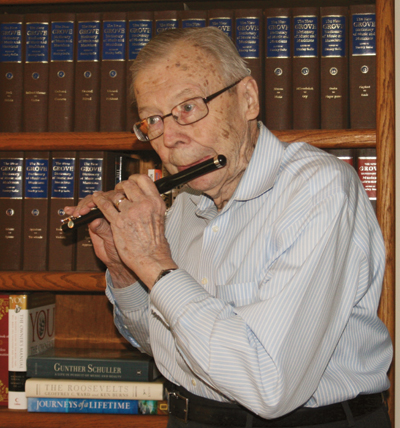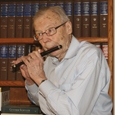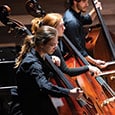 Walfrid Kujala joined the Chicago Symphony under Fritz Reiner in 1954 as assistant principal flute and became principal piccolo in 1958. He was also principal flute of the Grant Park Symphony from 1955 to 1960. In 1962 he was appointed to the Northwestern University faculty as professor of flute. He had previously been a member of the Rochester Philharmonic from 1948 to 1954, and taught at the Eastman School of Music where he had received his BM and MM degrees and studied flute with Joseph Mariano. He retired from the Chicago Symphony in 2001, and in 2012 became professor emeritus at Northwestern University.
Walfrid Kujala joined the Chicago Symphony under Fritz Reiner in 1954 as assistant principal flute and became principal piccolo in 1958. He was also principal flute of the Grant Park Symphony from 1955 to 1960. In 1962 he was appointed to the Northwestern University faculty as professor of flute. He had previously been a member of the Rochester Philharmonic from 1948 to 1954, and taught at the Eastman School of Music where he had received his BM and MM degrees and studied flute with Joseph Mariano. He retired from the Chicago Symphony in 2001, and in 2012 became professor emeritus at Northwestern University.
How do you align the headjoint with the body?
The far edge of the embouchure hole is lined up with the middle of the key mechanism just like the Rockstro position for flute.
How do you care for your wooden piccolo?
I do nothing special other than carefully swabbing the bore during practice or performance breaks.
Do you wear one or two ear plugs?
None.
What alternate fingerings do you use on a regular basis?
In slow or moderate tempos I always finger the upper C#: 0230/1004. In rapid scale-type passages I almost always use R2 instead of R3 for F#. Of course I have a large number of special fingerings for p and pp passages in slow or moderate tempos.
How do you warm up?
I play two pages daily from the Extended Intervals chapter of my Flutist’s Vade Mecum book, 2nd edition.
Do you have any tuning tricks when playing in an orchestra?
Blending with the rest of the orchestra is the prime requirement for the piccolo, and that requires constant attention to intonation and tone quality. This sometimes requires special fingerings. I always give special attention to any prominent piccolo passages that are in octaves or unison with the xylophone, glockenspiel, or celeste, especially in works like Manuel de Falla’s Three-Cornered Hat and Sergei Rachmaninov’s Symphonic Dances. I do pre-rehearsal run-throughs with those players. I also do some private sessions with the Eb clarinet for works like Hector Berlioz’s Symphonie fantastique.
What are your thoughts on vibrato when playing the piccolo vs. the flute?
I am much more discreet on the piccolo, almost as if I were playing the clarinet. In fact, when I play the following phrase from Strauss’ Don Juan in unison octaves with the first clarinet, non-vibrato is essential for ensuring perfect intonation and blending.

Similarly, at rehearsal number 8 in Ravel’s Bolero, (see below) the two pianissimo piccolos (second piccolo in G major, first piccolo in E major) enhance the third and fifth harmonics respectively of each note of the first horn’s C major mezzoforte solo line. In addition, the celeste (marked piano) doubles the horn’s C major theme. The beautiful composite of colors that the piccolos and celeste add to the horn sonority would of course be ruined if the piccolos used vibrato.

When Bolero is included in piccolo audition lists, it is the E major version that is intended, but it is actually printed in the 2nd flute part, whereas the less demanding G major version is inexplicably printed in the regular piccolo part. Thus the two players must switch their parts for that section.
Berlioz’s La damnation de Faust is another notorious example of mixed-up placement of parts. For example, in Scene 12 there is a long virtuosic section (Will o’ the Wisp) for three piccolos (Rehearsal number 94) that eventually segues into the famous Menuet des follets (Rehearsal number 104). However, the 1st piccolo is printed in the 1st flute part, 2nd piccolo is in the 2nd flute part, and the 3rd piccolo is in the actual piccolo part. In most orchestras the principal flute, after consulting with the principal piccolo, will ask the library staff to edit the parts and restore the proper hierarchy as follows: piccolo plays 1st piccolo, 2nd flute plays 2nd piccolo, and 1st flute plays 3rd piccolo. (Mahler’s Symphony No. 3 has similar issues.)
Do you single tongue most things or do you double tongue?
I always double-tongue whenever the tempo is too fast for clear single-tonguing.
What are the top ten excerpts a piccolo player should know well?
Beethoven Symphony No. 9 in D minor, Op. 125 (“Choral”); Berlioz La damnation de Faust, H 111, Menuet des follets; Bartok Concerto for Orchestra, Sz. 116, BB 123 (3rd movement); Ravel Daphnis et Chloé; Rossini Semiramide Overture, Shostakovich Symphonies Nos. 6, 9, 15; Stravinsky Firebird, Tchaikovsky Symphony No. 4, Op. 36.
Which piccoloists influenced your playing?
Ernest Wagner, former principal piccolo of the New York Philharmonic was an important influence. When I was in junior high school, I always listened to the weekly Sunday afternoon radio broadcast concerts of the NY Phil under John Barbirolli. I admired the artistry not only of Ernest Wagner, but also that of John Amans, the esteemed principal flute. By coincidence, my very first method book was Foundation to Flute Playing by Ernest Wagner, so I had a special incentive to pay close attention to and emulate, his playing. Just recently I was pleasantly surprised to learn that Wagner had actually been a member of the Chicago Symphony back in 1894-98, and his father, Ernest Wagner, Sr. was in the percussion section.
Ben Gaskins was another influence. He was principal piccolo in the NY Phil (having succeeded Ernest Wagner) and was later in the NBC Symphony under Toscanini. Gaskins and I both joined the Chicago Symphony in 1954 under Fritz Reiner. Ben was principal piccolo and I was assistant principal flute. I was privileged to learn many “tricks of the trade” from him. Ben died suddenly in 1957, and I succeeded him.




